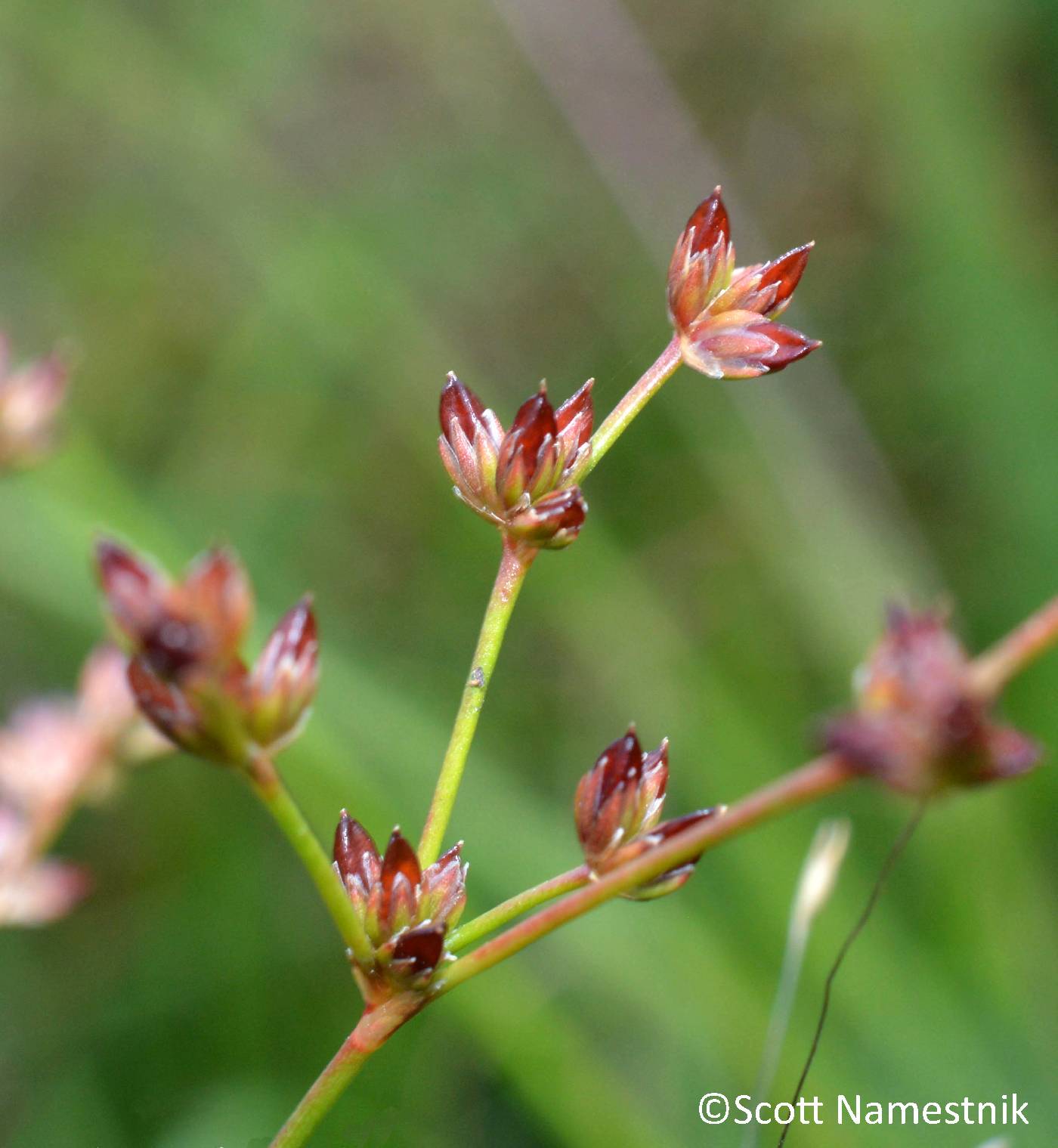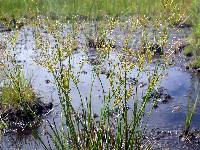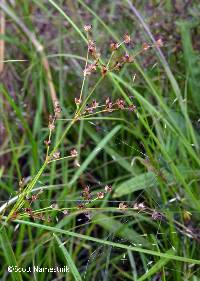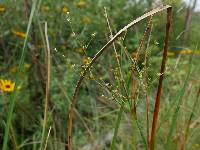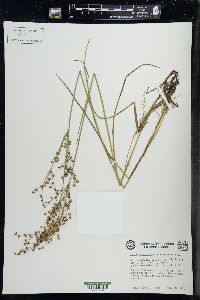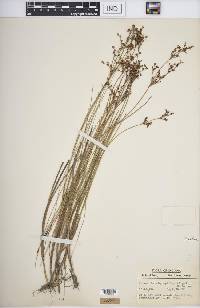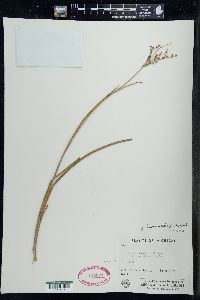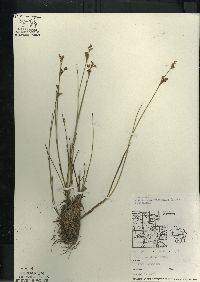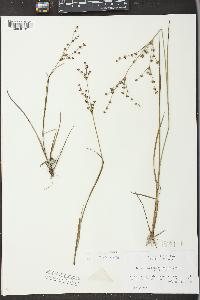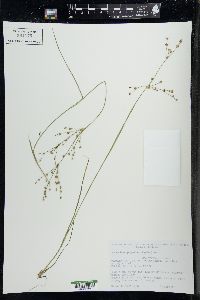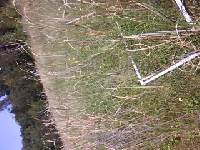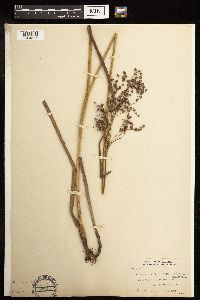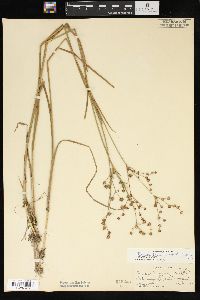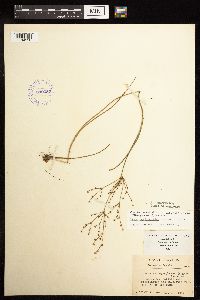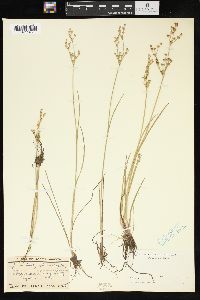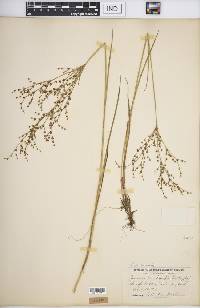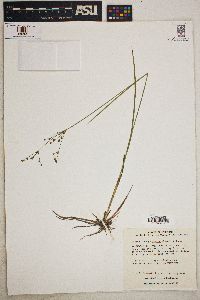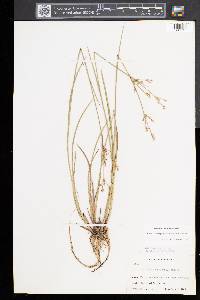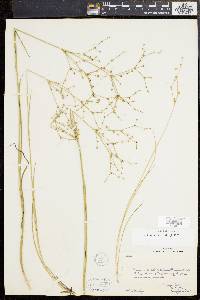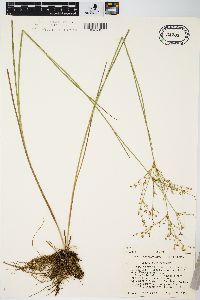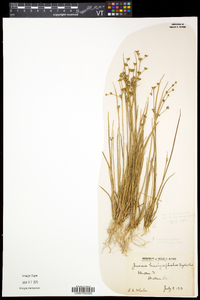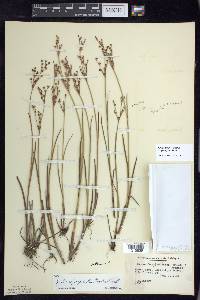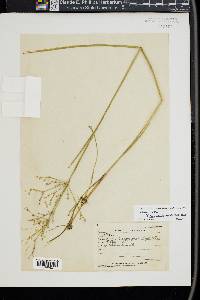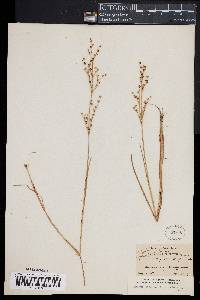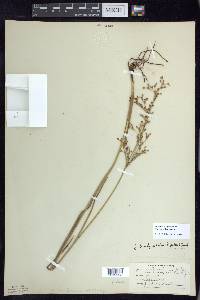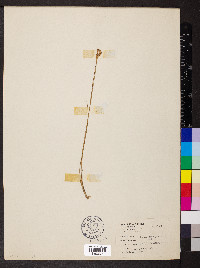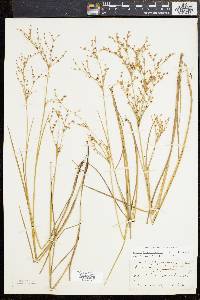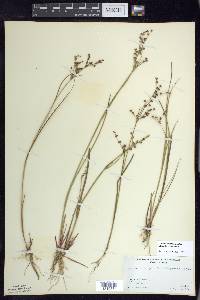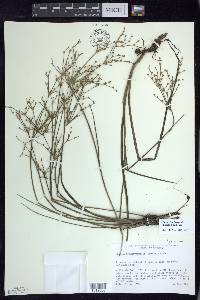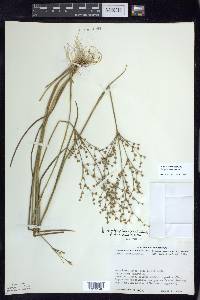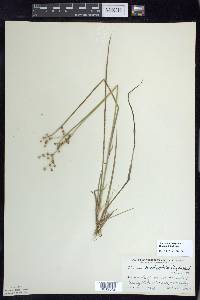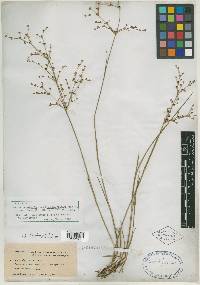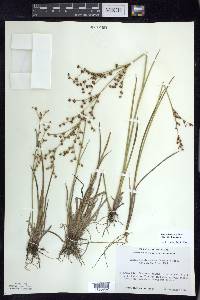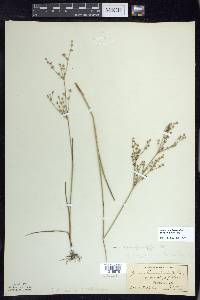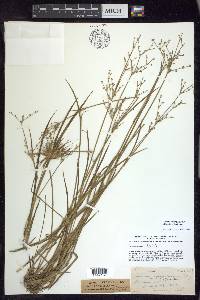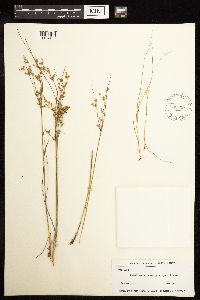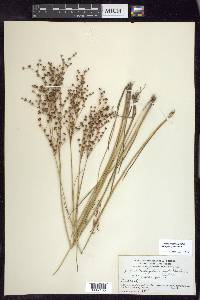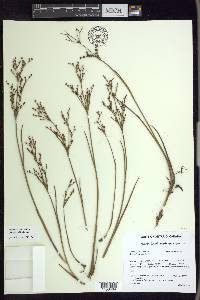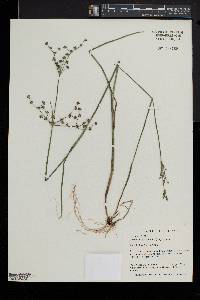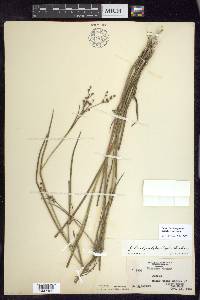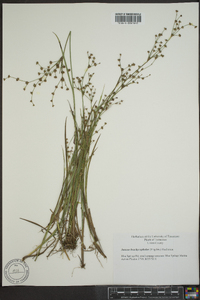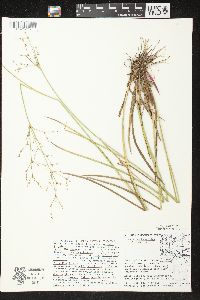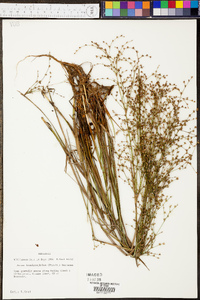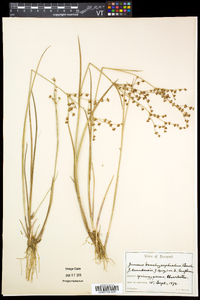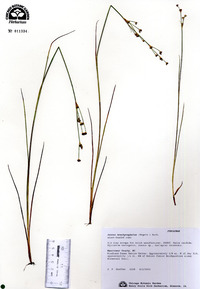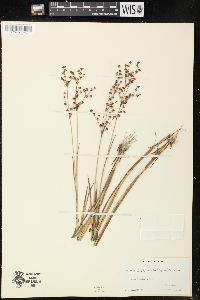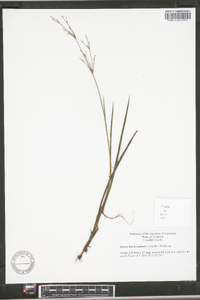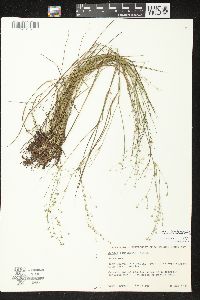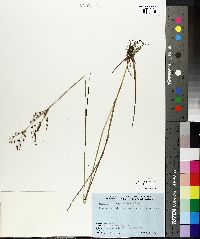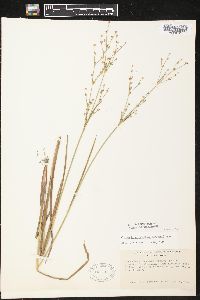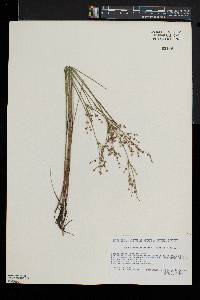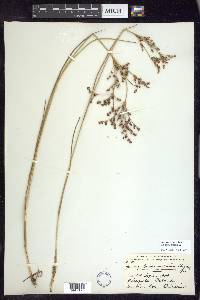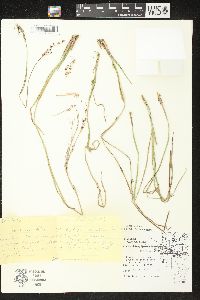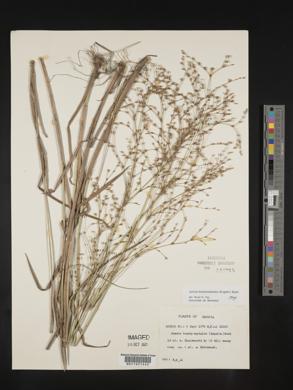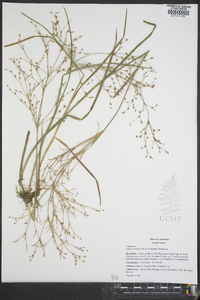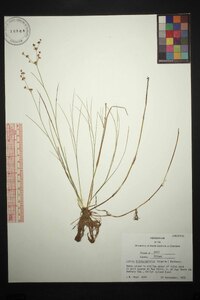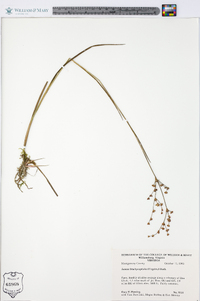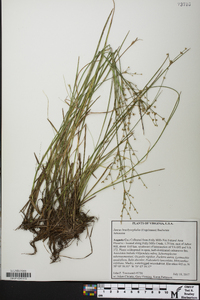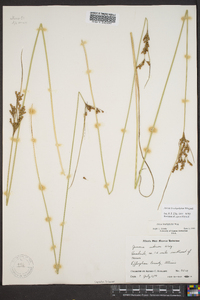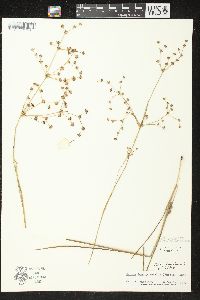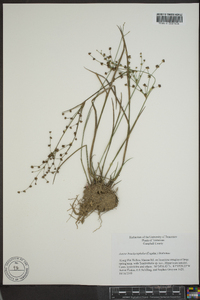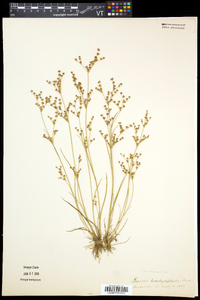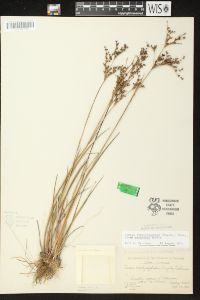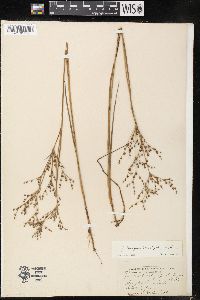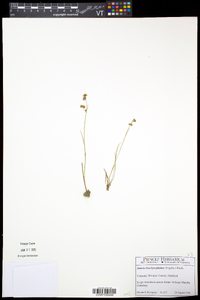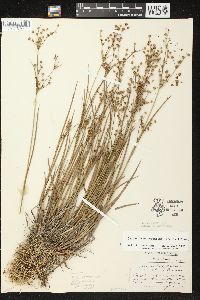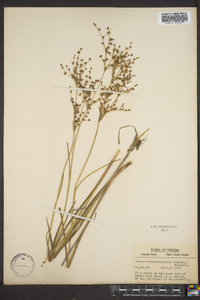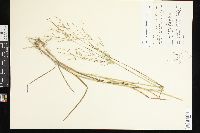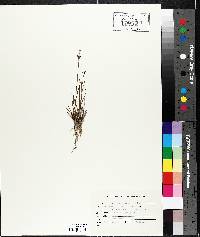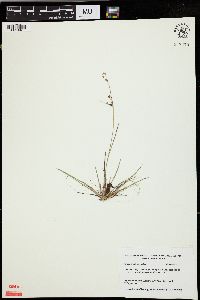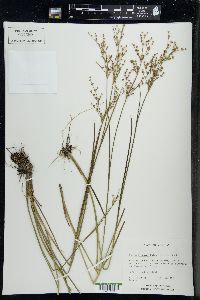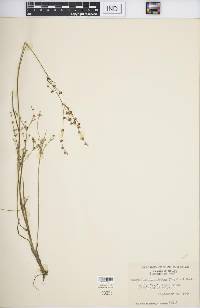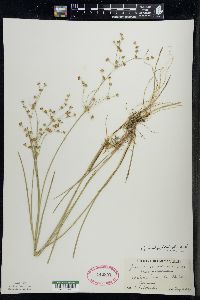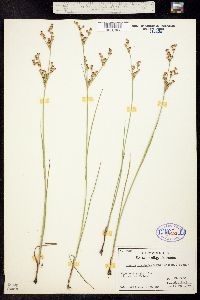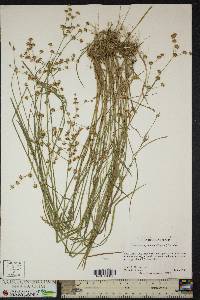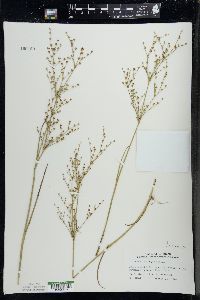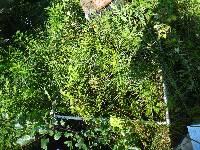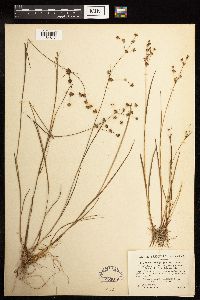Juncus brachycephalus
|
|
|
|
Family: Juncaceae
Small-Head Rush, more...smallhead rush
[Juncus brachycephalus f. hexandrus R. F. Martin, moreJuncus canadensis var. brachycephalus] |
Herbs, perennial, cespitose, 2--7 dm. Culms erect, 1--4 mm diam., smooth. Cataphylls 1--2, straw-colored to pink, apex acute. Leaves: basal 1--3, cauline 1--2; auricles 0.6--1.5 mm, apex rounded, scarious; blade terete to compressed, 0.2--12 cm x 0.5--2 mm. Inflorescences panicles of 5--80 heads, 5--25 cm, branches ascending; primary bract erect; heads 2--6-flowered, ellipsoid to obovoid, 2--5 mm diam. Flowers: tepals green to light brown, lanceolate; outer tepals 1.8--2.5 mm, apex obtuse to nearly acute; inner tepals 2--2.8 mm, apex obtuse to nearly acute; stamens 3 or 6, anthers 1/2 filament length. Capsules exserted, chestnut to dark brown, imperfectly 3-locular, obconic, 2.4--3.8 mm, apex acute proximal to beak, valves separating at dehiscence. . Seeds ellipsoid to fusiform, 0.8--1.2 mm, tailed; body covered with whitish translucent veil. 2n = 80. Fruiting summer--early fall. Calcareous marshes, wet meadows, and wetland shores; 100--200 m; N.B., N.S., Ont., Que.; Ala., Colo., Conn., Ga., Ill., Ind., Maine, Mass., Mich., Minn., N.H., N.J., N.Y., N.C., N.Dak., Ohio, Okla., , Pa., Tenn., Vt., Va., W.Va., Wis. Perennial grasslike forb 20 - 70 cm tall Leaves: one to three basal and one or two alternate on stem, 0.2 - 12 cm long, 0.5 - 2 mm wide, linear, grasslike, round or flattened in cross section, and with distinct crosswise partitions inside (septate). The leaves also have a thin and papery, basal, 0.6 - 1.5 mm long, round-tipped, ear-like appendage (auricle) at the top of the leaf sheath. Inflorescence: a terminal, 5 - 25 cm long, inversely egg-shaped (narrowest at base), spreading to ascending, branched structure with branches ending in five to eighty, ellipsoid to inversely egg-shaped, 2 - 5 mm diameter flower clusters. Each flower cluster is a compact head of two to six, tiny, radially symmetric flowers. Stamens: three or six, with anthers about half the length of the filaments. Pistil: with one superior ovary, and three stigmas. Fruit: somewhat three-chambered, chestnut to dark brown, 2.4 - 3.8 mm long (taller than tepals), three-angled, inversely cone-shaped, somewhat pointed-tipped capsules, which open down the sides. Stems: tufted, erect, smooth, slender, 1 - 4 mm in diameter. Seeds: many, whitish (due to translucent covering), 0.8 - 1.2 mm long, ellipsoid to narrowly spindle-shaped, widest at middle with distinctly narrowed tails at the ends. Tepals: six in two whorls of three, green to light brown, three-nerved, lance-shaped, with wide papery clear edges, and blunt or somewhat pointed tips. While the two ranks of tepals are very similar lengths, the outer three tepals are slightly shorter (1.8 - 2.5 mm) than the inner three tepals (2 - 2.8 mm). Similar species: Juncus brachycephalus is quite similar to smaller individuals of J. canadensis with small flower heads (fewer flowers per head), but that species has larger seeds (1.1 - 1.9 mm long) and evidently pointed tepals. Most similar is a species that is unlikely to be found in the Chicago Region, but is more northern, J. brevicaudatus. That species differs by having larger tepals (2 - 3.5 mm long) which lack the wide clear papery area along the edges, and the outer three tepals are always pointed and often long tapering. Flowering: June to October Habitat and ecology: Characteristically found in calcareous sandy soils such as marshes, wet meadows, pannes, and other sandy shores or springy sites. Occurence in the Chicago region: native Notes: At times Juncus brachycephalus has been considered a variety of J. canadensis, but most authorities now agree it is a separate entity. Others have also believed two closely related species, J. brevicaudatus and J. subcaudatus, were the same species as J. brachycephalus. To be fair, there is some overlap in the three species, but differences occur in the tepal shape and inflorescence branch orientation (Brooks and Clemants 2000). Etymology: Juncus is the classical name for Rush. Brachycepahalus is from the Greek words brachys, meaning short, and cephalus, meaning head, in reference to the small flower heads of this species. Author: The Field Museum Stems slender, densely cespitose, 3-7 dm; lvs terete, septate, often spreading, 1-2 mm thick; infl ovoid or pyramidal, 3-15 cm, half to two-thirds as wide, usually with numerous spreading-ascending or somewhat outcurved branches and numerous turbinate, 2-5-fld heads, in small plants the branches few and shorter and the heads few; fls eprophyllate; tep lance-oblong, 3-nerved, conspicuously scarious on the margins, obtuse or subacute, the sep 1.8-2.5 mm, the pet a bit longer; stamens 3 or sometimes 6; fr trigonously prismatic or subtriquetrous, evidently exceeding the perianth, 2.4-2.8 mm, abruptly narrowed to the short beak, subtrilocular, the partitions complete only near the base; seeds fusiform, 0.8-1.2 mm, the body occupying three-fifths of the length; 2n=80. Wet meadows and sandy shores; Me. to n. Ont. and Wis., s. to Pa., O., and Ind.; reported from n. Ga. Gleason, Henry A. & Cronquist, Arthur J. 1991. Manual of vascular plants of northeastern United States and adjacent Canada. lxxv + 910 pp. ©The New York Botanical Garden. All rights reserved. Used by permission. From Flora of Indiana (1940) by Charles C. Deam Frequent in the northern half of Indiana, becoming common in the lake area. It is often associated with other rushes, especially with J. nodosus, on low sandy or marly borders of lakes, in marshes and sloughs, and on springy calcareous terraces. A form of this species having six stamens instead of the more usual three has been named J. brachycephalus f. hexandrus Martin (Rhodora 40: 460. 1938) and Deam no. 54539A in the Herbarium of the University of West Virginia is designated as the type. The six-stamened condition is frequent in J. brachycephalus (as in J. canadensis and related species) ; in fact most of the Indiana collections have at least a few of the flowers with six stamens. As a rule a single plant will have flowers predominantly either 3-stamened or 6-stamened; occasionally the number will be about equally divided between the two, but rarely, if ever, is a plant found in which all of the flowers have reverted to the 6-stamened state. …… Indiana Coefficient of Conservatism: C = 7 Wetland Indicator Status: OBL |

